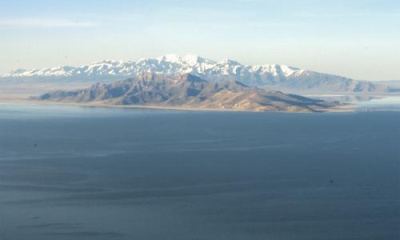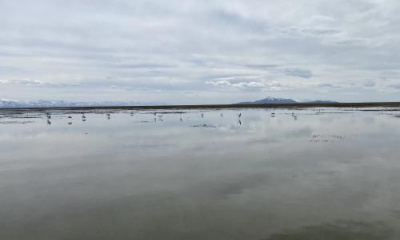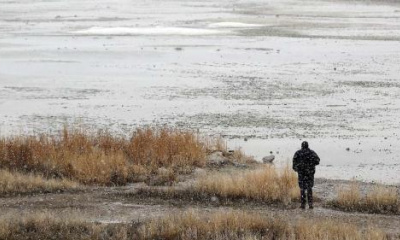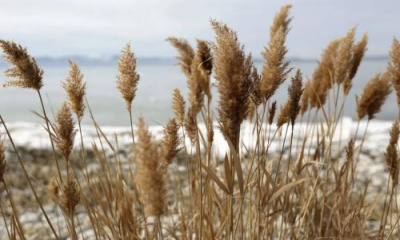Aral District, Kazakhstan • When Akshabak Batimova was growing up, her father left their village in western Kazakhstan each morning to fish in the Aral Sea — until recently, one of the world’s largest lakes.
Batimova’s father returned home each night with large, speckled pike and fat carp for dinner. Fishing became the family’s identity. Batimova’s first name means “perch” in Kazakh.
As a girl growing up in the ‘60s, Batimova overheard old-timers in her village talking about how the lake was shrinking. But it was only after she left to study marine biology in Russia and returned home one summer after a year away that Batimova noticed the changes herself.
“I went to the place by the lake where we used to swim, but you couldn’t see water anywhere,” Batimova said.
Once the fourth-largest lake on the planet, today it is estimated that the Aral Sea in Central Asia has dried up to just a tenth of its size. Around 60 years ago, when the region was still part of the Soviet Union, authorities diverted the main rivers that feed the Aral Sea to irrigate one of the world’s largest cotton farming operations. In just three decades, the lakeshore shrunk miles away from communities like the fishing village where Batimova grew up.
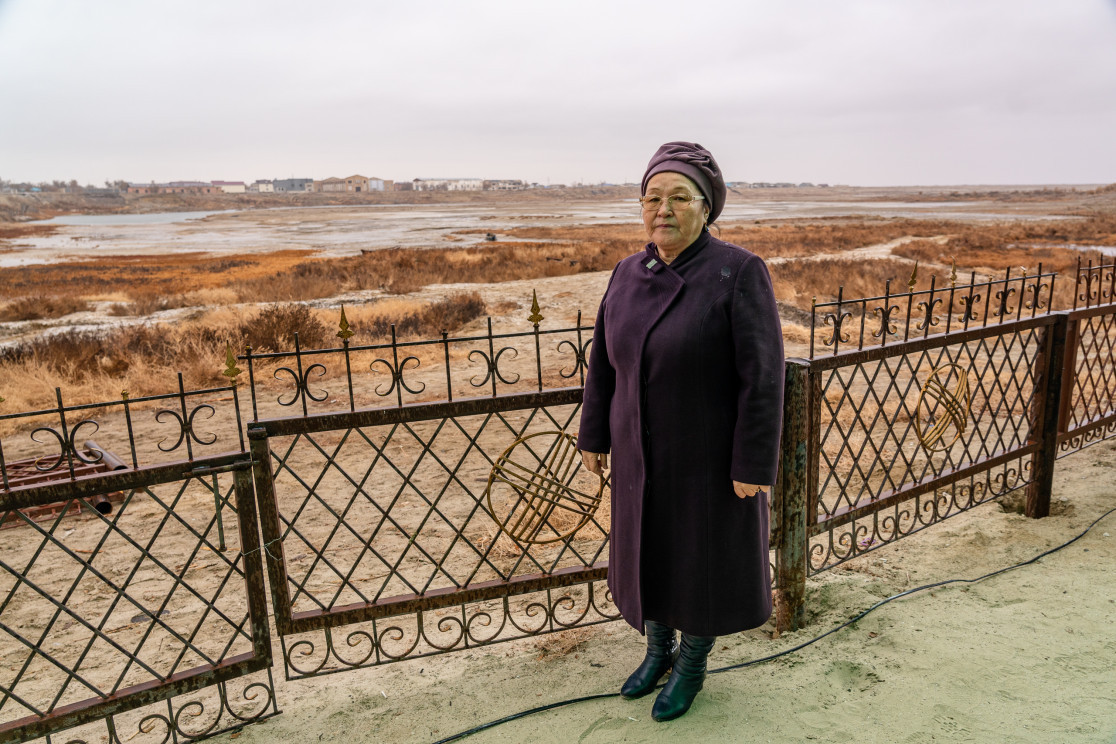
(Abduaziz Madyarov | The Great Salt Lake Collaborative) (Abduaziz Madyarov) Akshabak Batimova, 67, stands by the now mostly dried-up bay along the former port in Aral, Kazakhstan, Wednesday, Nov. 8, 2023. After the Aral Sea dried up, it devastated the livelihood of locals like Batimova who worked as a researcher for a local fish plant. But a dam completed in 2005 that divided the lake managed to save the fishery.
Today, rusty cranes that once hoisted cargo from ships in the former Kazakh port town of Aral rise above a dried-up bay overgrown with spindly shrubs. Several freshly painted fishing boats stand on the town’s boardwalk, monuments to a former way of life. In the distance, camels roam through a vast desert where fish once swam.
The retreat of the Aral Sea serves as a cautionary tale for the potential fate of the Great Salt Lake. If Utahns fail to manage the stresses that agriculture and human consumption place on their own inland sea, it could decimate the state’s lucrative brine shrimp industry, cause global bird populations to crash and create toxic dust storms that would gravely affect the health of residents across the Wasatch Front and beyond.
In western Kazakhstan, this doomsday scenario has already become reality.
By the ‘80s, the Aral Sea’s salinity had spiked, eventually killing off its native fish. Surrounding communities that depended on fishing saw their economies crash. Residents like Batimova, who worked as a researcher monitoring the Aral Sea’s fish, found themselves unemployed. Dust storms kicked up sediment and pesticides from the dry lakebed, contaminating the air. Locals in the region now experience a range of health problems scientists link to the Aral Sea’s dust, including high rates of cancer, kidney problems and infant mortality rates that are nearly twice the global average.
“The Aral Sea shrinking is a result of the same problem that we have here in the Great Salt Lake watershed,” said Bonnie Baxter, a biology professor and director of the Great Salt Lake Institute at Westminster University in Salt Lake City.
But the Aral Sea also offers some insight into how Utah might keep the Great Salt Lake viable in a future world with less water.
The lake in Central Asia spans two nations — Kazakhstan and Uzbekistan. And because Uzbekistan never showed strong interest in conservation or reversing the lake’s decline, Kazakhs built an 8-mile dam to save their portion of the Aral Sea.
Construction of the Kok-Aral Dam wrapped up in 2005 and cost nearly $86 million in U.S. dollars. The lake’s water level quickly increased by more than 10 feet.
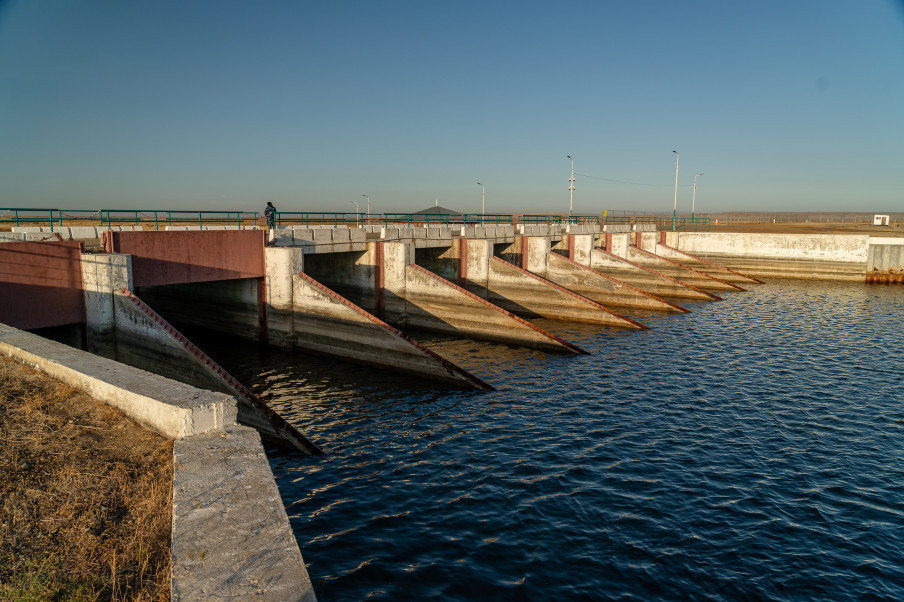
(Abduaziz Madyarov | The Great Salt Lake Collaborative) The Kok-Aral Dam in western Kazakhstan, pictured Tuesday, Nov. 7, 2023, was completed in 2005. The nearly $86 million project separated the northern section of the Aral Sea from the rest of the lake, allowing one of the Aral's main tributaries to fill a smaller part of the original lake's basin. The construction managed to save a large portion of the Aral Sea from drying up.
The dam spans a narrow strait that connects the north and south arms of the lake. Sandy embankments covered in patches of tall grass gradually extend off either side of the dam down to reedy marshland. From a distance, the construction looks more like a long sandbar than a dam.
The region’s dust storms, although still a problem, are now less intense, at least on the Kazakhstan side. Freshwater fish were reintroduced to the lake, rejuvenating the fishery and creating jobs.
This portion of the lake, called the North Aral Sea, now spans about 1,000 square miles, compared to the 26,000 square miles the sea covered in the 1960s. The Great Salt Lake, by comparison, currently covers about 950 square miles.
Researchers in the Aral Sea region believe that manufacturing a smaller lake by separating it with a barrier could be an effective way to retain parts of the Great Salt Lake as well.
“It’s much better to save a portion of the lake than to just sit down and give up,” said Ainagul Baimakhanova, director of the NGO Aral Tenizi, a group dedicated to saving the Aral Sea.
Lakes divided
Last year, resource managers with the Utah Department of Natural Resources made a similar decision to keep the southern portion of the Great Salt Lake’s ecosystem functional.
A rock-filled railroad causeway has long bisected the lake, creating a much saltier northern arm where only saline-loving microorganisms can survive. They turn the water a pinkish-purple hue. In 2017, the Department of Natural Resources opened a breach in the causeway so fresher water could reach the northern half again and revive its ecosystem.
But as lake levels dropped to a record low in 2021, and another record low in 2022, biologists and other lake advocates worried the entire lake and all the life it supports was about to collapse.
News stories and policy discussions have largely focused on the lake’s receding elevation. But scientists like Baxter caution that the real numbers that matter for the lake’s ecology are salinity levels. Water that’s 12% to 15% salt is the “happy place” for supporting the food web. By the end of 2022, the southern half’s water had spiked to 19% salt. Brine flies had all but disappeared. Brine shrimp were struggling. Migrating birds became harder and harder to find.
A state-appointed salinity advisory committee prepared advice for the department and the governor, recommending they fill in the causeway breach again.
It was also the fastest way to save at least part of the Great Salt Lake — all workers had to do was use a backhoe to move rocks around.
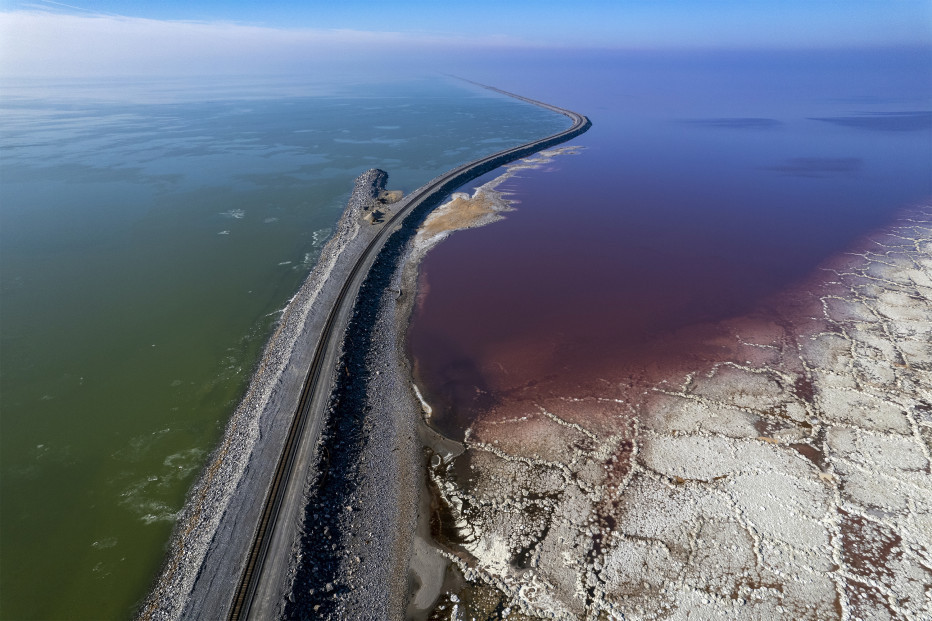
(Rick Egan | The Salt Lake Tribune) A railroad causeway divides two halves of the Great Salt Lake, pictured Friday, Dec. 29, 2023.
“That’s important,” said Baxter, who serves on the salinity advisory committee, “because this crisis is one that needs to be solved quickly.”
And because the causeway was already there, built and maintained by railroad companies, it cost the state virtually nothing. Most importantly, Baxter said, it worked.
“It’s a simple solution,” Baxter said. “And it helped us preserve the south arm.”
Filling in the causeway, combined with unprecedented snowmelt, meant the southern half currently sits about 3.5 feet higher than at this time last year. Its salinity is back in the safe range of 14%.
But Utahns don’t have to resign themselves to living with a smaller lake, as Kazakhs have with the Aral Sea, Baxter said.
The six countries that share the tributaries feeding the Aral Sea have yet to agree on an effective water management strategy, and each year, more water upstream gets siphoned off for agriculture and other uses.
The Taliban in Afghanistan recently launched construction of a 115-mile canal that, upon completion, will divert an estimated 20% of the water away from the main tributary that feeds the southern part of the Aral Sea in nearby Uzbekistan.
“I think about the Aral Sea and how that was a losing battle,” Baxter said, “because those people can’t talk to each other across borders.”
While the Great Salt Lake’s largest tributary, the Bear River, weaves through three different states — Utah, Idaho and Wyoming — it’s easier to communicate and collaborate across the watershed and develop solutions, if water users are willing.
Climate change will likely fuel drier conditions across the West, but as with the Aral Sea, the Great Salt Lake’s biggest threat remains people diverting the water that would otherwise reach it. A white paper produced by Utah scientists in 2017found the lake would sit 11 feet higher if not for diversions. And a policy assessment prepared by the Great Salt Lake Strike Team last year found human water consumption is responsible for 67% to 73% of the lake’s decline.
“We should find motivation to make this better,” Baxter said. “The thing that we can really pull the lever on is how much water we use.”
And abandoning half of the Great Salt Lake comes with costs. One of the largest colonies of nesting pelicans have abandoned their rookery at a former island in the north half. Compass Minerals, the largest and most profitable mineral extractor on the lake, struggles to access the brine it needs to make organic fertilizers that help grow food across the hemisphere. And a protective salt crust covering the north half’s vast exposed lakebed is weathering away by the day, which could bring more intense and frequent toxic dust storms.
“[The causeway] is a temporary solution,” Baxter said. “There’s no way this can work long term, if the amount of water coming into the lake doesn’t change.”
A shaky success
Communities on the Kazakh side of the Aral Sea have also learned the success of diking off a smaller portion of the lake has its limitations.
“Our data shows that the amount of water reaching the Aral Sea is steadily decreasing,” said Nurlan Sambaev, head of the Aral branch of Kazakhstan’s Scientific Center for Fisheries.
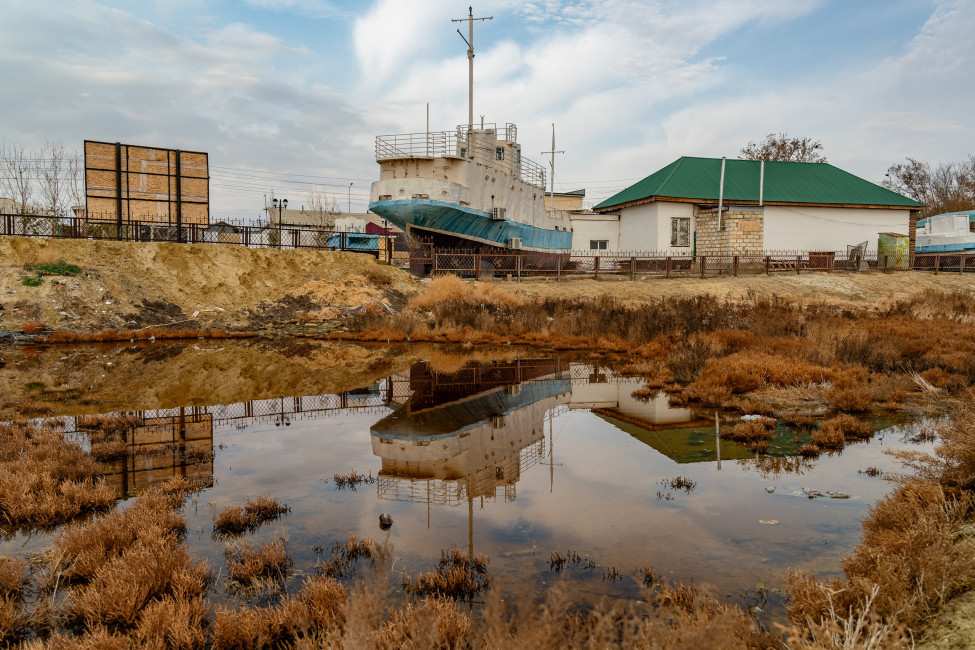
(Abduaziz Madyarov | The Great Salt Lake Collaborative) An old boat stands by the now mostly dried-up bay in Aral, Kazakhstan, Wednesday, Nov. 8, 2023, as a monument to a way of life that vanished when the Aral Sea began to significantly disappear in the 1980s.
In the last several years, the salinity level in the Kazakh side of the lake has rapidly increased, once again putting fish stocks under threat.
On a recent winter afternoon, Kazakh fishermen complained about 2023′s poor catch as they loaded nets onto small fiberglass fishing boats.
“The lake is becoming much smaller and the financial situation of fishermen is getting worse every day,” said Aidarbek Altay Uly as he prepared to push his boat through the shallow waters to a distant point on the horizon where the lake finally became deep enough to fire up the motor.
The current situation facing the Kazakh side of the Aral Sea reveals another important lesson for Utah: Even the best solutions for saving a lake can quickly unravel without long-term conservation strategies that farmers and communities upstream will follow.
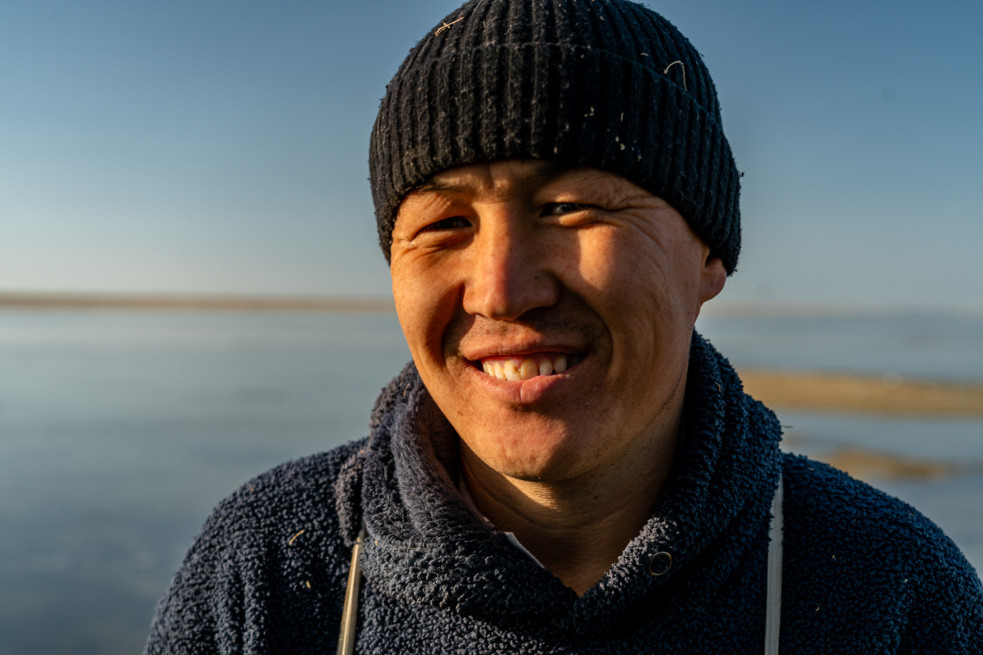
(Abduaziz Madyarov | The Great Salt Lake Collaborative) Kazakh fisherman Aidarbek Altay Uly, pictured Tuesday, Nov. 7, 2023, says that the section of the Aral Sea where he fishes has significantly shrunk in recent years and that the lake's fish are once again disappearing as the water becomes more saline.
But Kazakh officials and the locals who remain near the lake haven’t given up hope. After a half-century living alongside a stressed body of water, they are used to innovating quickly.
Many Kazakhs who remain in the Aral Sea region believe that adaptation is a better option than moving elsewhere. They are determined to stay near the lake that has supported their community and families for generations.
“Where am I supposed to go anyway — Salt Lake City?” joked Darkhan Yembergenov, a local fisherman. “There’s no water there either.”

